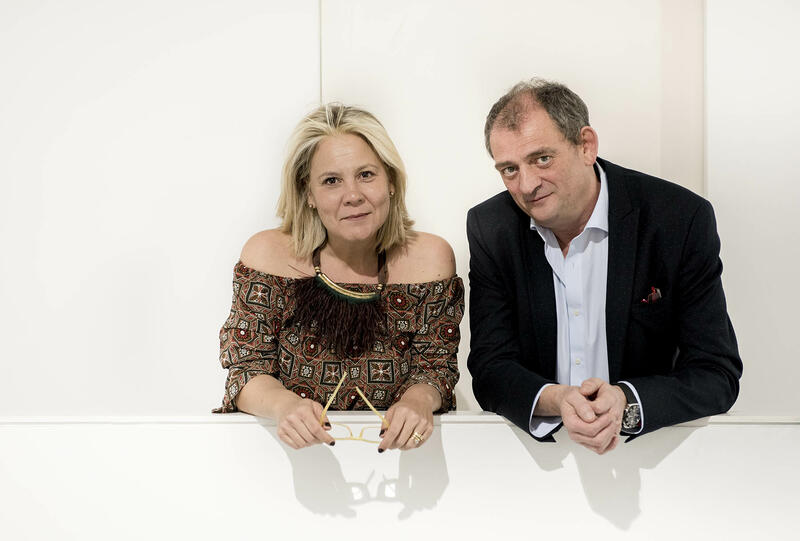PONCE+ROBLES: 50 YEARS OF WORK AND AN AMBITIOUS CURATORIAL PROJECT FOR 2021
Ponce + Robles gallery is launching a project dedicated to celebrate 50 years of Raquel Ponce and José Robles (30 years for her, 20 years for him) as gallery owners on the Spanish contemporary art scene. The project consists of four exhibitions and will occupy the gallery's entire programme in 2021.
The project, as Raquel Ponce explains, is a throwback to origins: "Any change, and even more one like the one we are going through now implies a return", she explains. Thus, Ponce+Robles has brought together four renowned curators from the Latin American contemporary art scene to develop a collective exhibition around one of the four elements: Earth —element that inaugurated the project with the exhibition Tierra a la vista until 30 of April— curated by David Barro (Spain, 1974); Fire, under the curatorship of Pili Estrada Lecano (Ecuador, 1981); Water, by Susanna Tempkin (USA, 1985); and Air, conceived by Tiago de Abreu (Brazil, 1984).

The first two exhibitions that constitute the 50th anniversary project of Pone+Robles are Earth and Water. In the first case, under the curatorship of David Barro, the exhibition Tierra a la vista inaugurated this curatorial cycle on February 4. The artists Gabriela Albergaria, Ricardo Calero, Menchu Lamas, Verónica Moar, Inês Teles and Françoise Vanneraud constitute a dialogue around the notion of landscape using multiple "found forms" as the material for their artworks. The selected works are characterised by the possibilities that, through the appropriation of natural elements, produce new ways of understanding landscape and manifest the territoriality of pictorial and sculptural language.
As for the exhibition dedicated to Water, which is still in progress, the North American curator Sussana Tempkin has chosen to call it La memoria del agua (The Memory of Water). Taking the central concept of Benveniste's scientific theory, the artworks of the five artists that will form part of the project —Genesis Báez, Raúl Díaz Reyes, Frances Gallardo, Lina Puerta and Evelyn Rydz— will be oriented towards representing the metaphysical value that water has as a producer of narratives of history, imagination and the physical world. Thus, and making use of diverse disciplines, the artists "refer to the power of water to hold stories, leave physical stains and emotional traces, heal traumas and resonate in our minds, hearts and ears," Tempkin states in the project statement.
-
Tierra a la vista, exhibition view. Ph: cortesía de la galería.
-
Tierra a la vista, exhibition view. Ph: cortesía de la galería.
-
Tierra a la vista, exhibition view. Ph: cortesía de la galería.
-
Tierra a la vista, exhibition view. Ph: cortesía de la galería.
-
Tierra a la vista, exhibition view. Ph: cortesía de la galería.
Regarding the two remaining exhibitions (Fire and Air), which will take place in the second part of the year, the curators Tiago de Abreu Pinto and Pilar "Pili" Estrada Lecano are still at an early stage of the projects.
Tiago de Abreu Pinto is an independent Brazilian curator who has been living in Madrid for several years. He has been a member of the NoguerasBlanchard gallery team for five years, where he later held the position of director. He has also been recognised for his work in the Community of Madrid and is Special Correspondent of the Future Generation Art Prize Pinchuk Foundation, in Ukraine.
Pili Estrada Lecano, on the other hand, is the director of the Centro de Producción e Innovación de la Universidad de las Artes, in the city of Quito, and has worked as director of the Centro Cultural Metropolitano, in charge of the programming of the space. She also managed the space NoMíNIMO for seven years, where she developed a public training laboratory, promoting collecting in the Ecuadorian art scene.
It is worth mentioning the curators' trajectory because it highlights the value of the project that the gallery owners Raquel Ponce and José Robles bring to the Madrid scene. In the midst of the health crisis, they affirm that the work in the gallery has multiplied, and that they see the current context as an opportunity to develop collaborative projects of this type. In the midst of the chaos, Ponce+Robles is an example of good gallerism and the will to move the art industry forward in complicated times. The recipe? Work, communication and collaboration between agents and institutions.


